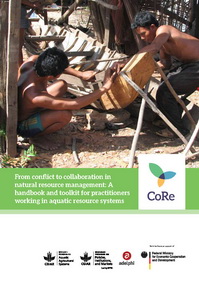The handbook and toolkit can be used to support any participatory process aimed at
sustainable resource and conflict management. In particular, it is intended to support efforts using the Collaborating for Resilience approach described in the accompanying practitioner’s guide. The CORE approach provides a framework for understanding stakeholder interactions and organizing for social and institutional change, distinguished by its emphasis on whole systems, an open search for solutions, and explicit treatment of power. These characteristics make the approach especially well suited to catalyzing collective action to address shared challenges of natural resource management.
While the tools and approaches covered in this handbook and toolkit can be applied to a wide range of local natural resource management challenges, we highlight guidance for managing local conflicts over aquatic resources, and the examples described focus on aquatic resources. Aquatic resources refer to water and its multiple roles in sustaining livelihoods, the environment and ecosystem services.4 This includes water itself as it is used for agricultural, commercial, industrial and domestic purposes, animals and
plants that live in the water such as fish and algae, and aquatic ecosystems such as coral
reefs and mangroves, as well as the ecosystem services they provide. This document does not specifically address issues around extractive resources that are located in the sea bed or underneath water bodies such as lakes. The approaches and tools described here are tailored toward local and community-based conflicts, such as those between different communities, between communities and government agencies, or between communities and commercial resource users. The handbook and toolkit targets practitioners with experience in water and aquatic resource management, or natural resource management more broadly, but with little or no conflict management experience. This includes those with exposure to the CORE approach who are seeking more detailed guidance on how to put the approach into practice, including guidance on selecting appropriate tools and methods for the context at hand.
Section 1 outlines key drivers and dynamics of aquatic resource conflict in order to explain how conflict factors — such as inequitable distribution of resources — interact to escalate a crisis into a conflict. This section provides background information and guidance on how to do a preliminary conflict assessment.
Section 2 explains conflict management, discusses what role it plays in natural resource
management, and describes different conflict management institutions and approaches. The main focus of this section is on alternative conflict management approaches that try to find solutions producing gains for all stakeholders to create sustainable cooperation. Besides introducing important elements of conflict management such as conciliation, negotiation, facilitation and mediation, the section also points out how to determine and create key success factors.
Section 3 gives an introduction to participatory monitoring and evaluation of conflict
management processes and projects. This approach emphasizes stakeholders and their
knowledge: Monitoring and evaluation are understood as a learning process that should
involve all stakeholders and beneficiaries. This section introduces how to monitor the
conflict management outcomes and impacts of an initiative and provides an overview of the common challenges that arise. It also provides a quick overview and links to further reading for a number of tested monitoring and evaluation approaches for conflict management initiatives.
Sections 1–3, the handbook portion of this handbook and toolkit, provide the background knowledge and guidance for integrating conflict management into aquatic resource management. This is followed by the toolkit, which provides tools and exercises to put the concepts into practice. They are structured along four main
categories: analysis tools aimed at assessing problems and conflicts and creating a common understanding; dialogue and consensus building tools that help to foster cooperation and overcome obstacles in the process; strategy development tools that help to identify, test and design strategies and solutions; and flexible Support tools that can be used during different parts of the process. Each tool is described in detail, including a step-by-step run through and suggestions for further reading. Depending on the context, the issues at hand and the intensity of conflict, it may be necessary to draw in specialized support from professionals trained in facilitation, mediation or negotiation. In addition to providing guidance to help orient those new to the field of conflict management and cooperation, we hope this handbook can help clarify when such additional support is needed.
